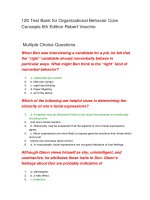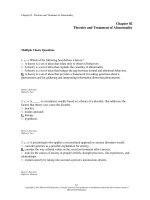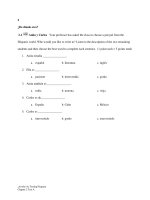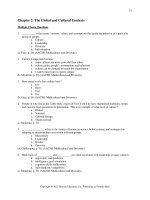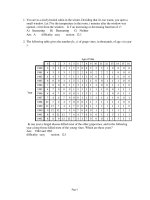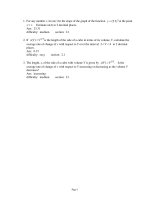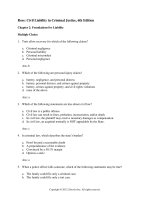Managing behavior in organizations 6th edition jerald greenberg test bank
Bạn đang xem bản rút gọn của tài liệu. Xem và tải ngay bản đầy đủ của tài liệu tại đây (434.92 KB, 18 trang )
Chapter 1 The Field of Organizational Behavior
1.1 Multiple Choice Questions
1) ________ is defined as ʺthe multidisciplinary field that seeks knowledge of behavior in
organizational settings
by systematically studying individual, group, and organizational processes.ʺ A) Industrial
psychology B) Organizational psychology C) Behavioral science D) Organizational behavior
Answer: D
Diff: 2 Page Ref: 4 LO: 1
2) Limitations of case studies include: A) It is expensive and time consuming to collect data. B)
Empirical techniques may skew results. C) Findings may not be generalizable to other
organizations. D) Confidentiality is difficult to maintain.
Answer: C
Diff: 5 Page Ref: 5 LO: 2
3) In ________, behavior is studied carefully to see how a particular variable that is systematically
varied affects
other aspects of behavior. A) naturalistic observations B) experimental research C) case studies D)
survey research
Answer: B
Diff: 5 Page Ref: 5 LO: 2
4) Organizational behavior focuses on three interrelated levels of analysis: A) emotions, intentions, and
actions. B) planning, executing, and results. C) individuals, groups, and organizations. D)
thinking, feeling, and doing.
Answer: C
Diff: 5 Page Ref: 5 LO: 2
5) OB specialists derive knowledge from a wide variety of social science disciplines. ________ is useful for
studying negotiation and decision making. A) Psychology B) Political science C) Economics D)
Sociology
Answer: C
Diff: 2 Page Ref: 7 LO: 2
6) Which of the following assumes that people are basically lazy, dislike work, need direction, and will only
work
hard when they are pushed into action? A) Scientific management B) Time and motion study C) Theory Y
philosophy D) Theory X orientation
Answer: D
Diff: 5 Page Ref: 8 LO: 3
7) Theory Y assumes that people A) are motivated primarily by financial incentives. B) are basically lazy and
irresponsible. C) have social needs that influence their choices of work and employment. D) have a
psychological need to work and seek responsibility.
Answer: D
Diff: 5 Page Ref: 8 LO: 3
8) Employers need to be concerned about job satisfaction because A) satisfied employees are less likely to quit
than those who are dissatisfied. B) accurate performance appraisal often causes job dissatisfaction. C)
people are more satisfied when they are not required to work too hard. D) a satisfied employee is more
productive than a dissatisfied employee.
Answer: A
Diff: 5 Page Ref: 10 LO: 3
9) Which of the following organizations are, on average, twice as profitable as the Standard & Poorʹs 500
companies? A) A company whose managers accurately appraise the work of their subordinates. B) A
business that developed a system of close supervision to monitor closely the work of its employees. C)
An organization that treats its employees well with respect to pay and benefits, offers opportunities,
provides job security, and shows fairness. D) A family-owned organization that gives priority to hiring and
promoting friends and relatives of the owners. Answer: C
Diff: 9 Page Ref: 10 LO: 3
10) The ________ approach recognizes that behavior in work settings is the complex result of many interacting
forces. A) contingency B) one-best-way C) scientific management D) open-systems
Answer: A
Diff: 6 Page Ref: 10 LO: 3
11) A(n) ________ is defined as a structured system consisting of groups and individuals working together to
meet
some agreed-upon objectives. A) task force B) team C) open system D) organization
Answer: D
Diff: 2 Page Ref: 11 LO: 4
12) What is an open system? A) A structured social system consisting of groups and individuals working
together to meet some
agreed-upon objective. B) A system of communication that promotes two-way conversation. C) An
interactive dialog incorporating feedback from all stakeholders. D) A self-sustaining system that uses
energy to transform resources from the environment into some form of
output. Answer: D
Diff: 8 Page Ref: 11 LO: 4
13) ________ often occurs when organizations need far fewer people to operate today than in the past. A)
Rightsizing B) Outsourcing C) Automating D) Offshoring
Answer: A
Diff: 5 Page Ref: 14 LO: 4
14) Telecommuting involves A) restricting the personal use of the Internet and e-mail. B) using electronic
equipment to permit conferences to be held at remote locations. C) permitting employees to choose what
hours they will work. D) using communications technology to enable work to be performed from remote
locations.
Answer: D
Diff: 3 Page Ref: 15 LO: 4
15) The underlying principle of scientific management is to A) structure organizations for the efficient
management of people. B) apply statistical analysis to the design of jobs. C) get people to do more work
in less time. D) eliminate the need for first-line supervisors.
Answer: C
Diff: 6 Page Ref: 21 LO: 5
16) Who published the groundbreaking book Principles of Scientific Management in 1911? A) Elton W. Mayo B)
Frank & Lillian Gilbreth C) Frederick Winslow Taylor D) Max Weber
Answer: C
Diff: 5 Page Ref: 21 LO: 5
17) Frederick Winslow Taylor recommended that A) a bureaucracy be established to provide order in the
workplace. B) employees be carefully selected and trained to perform their jobs. C) a standard hourly
wage be implemented to discourage absenteeism. D) workers be given more autonomy in the operation
of their jobs.
Answer: B
Diff: 9 Page Ref: 21 LO: 5
18) Frederick Winslow recommended that increasing employee wages would A) improve the relationship
between managers and employees. B) make production costs too expensive and products less
competitive. C) raise employee motivation and make them more productive. D) encourage employees to
work fewer hours for the same weekly wage.
Answer: C
Diff: 9 Page Ref: 21 LO: 5
19) Industrial psychologists Frank and Lillian Gilbreth are best known for the development of A) time and
motion study. B) the bureaucratic model. C) assembly lines. D) the human relations movement.
Answer: A
Diff: 5 Page Ref: 21 LO: 5
20) Time and motion studies were designed to A) find the one best way to perform jobs. B) reduce the need for
close supervision of workers. C) set minimum qualifications needed by job holders. D) establish piecerate plans.
Answer: A
Diff: 3 Page Ref: 21 LO: 5
21) The human relations movement A) emphasized the importance of employee training and development. B)
encouraged employee participation in organizational decision making. C) rejected the primary economic
orientation of scientific management. D) concentrated on redesigning the workplace to eliminate safety
hazards.
Answer: C
Diff: 5
LO: 5
Page Ref: 22
Managing Behavior in Organizations, 6e (Greenberg) -CVC -8/1/2012 -Page 4
Copyright © 2013 Pearson Education, Inc. publishing as Prentice Hall
22) The human relations movement founded by Elton Mayo A) illustrated the importance of stable
families in an industrial society. B) recognized the primary economic orientation of workers. C)
found a consistent relationship between job satisfaction and productivity. D) focused on the
noneconomic, social factors operating in the workplace.
Answer: D
Diff: 5 Page Ref: 22 LO: 5
23) A major finding of the Hawthorne studies is that A) working conditions impact productivity. B)
employees work best without close supervision. C) organizations are social systems. D)
employees are economic creatures.
Answer: C
Diff: 5 Page Ref: 22 LO: 5
24) Classical organizational theory focused on A) establishing the means of controlling worker activities.
B) the efficient structuring of organizations. C) the effective allocation of monetary incentives. D)
effectively organizing the work of individuals.
Answer: B
Diff: 5 Page Ref: 23 LO: 5
25) Weber believed that ________ is the one best way to efficiently organize work in all organizations. A)
bureaucracy B) time and motion management C) scientific management D) Theory Y
Answer: A
Diff: 5 Page Ref: 23 LO: 5
1.2 True/False Questions
1) Organizational behavior applies common sense to the complexities of human behavior
at work. Answer: FALSE
Diff: 2 Page Ref: 4 LO: 2
2) The field of organizational behavior focuses on three interrelated levels of analysis: attitudes,
intentions, and behavior. Answer: FALSE
Diff: 5 Page Ref: 5 LO: 2
3) The micro approach to OB focuses primarily on the behavior of individuals. Answer: TRUE
Diff: 2 Page Ref: 5 LO: 2
4) Organizational behavior draws from the highly individual-oriented approach of psychology. Answer:
TRUE
Diff: 5 Page Ref: 7 LO: 2
5) The Theory X philosophy of management assumes that people have a psychological need to work and seek
achievement and responsibility. Answer: FALSE
Diff: 5 Page Ref: 8 LO: 3
6) Organizational behavior seeks to make organizations more profitable by addressing the treatment of people
and the way they do their jobs. Answer: TRUE
Diff: 5 Page Ref: 9 LO: 3
7) Organizational behavior researchers seek to find the one best way to motivate people. Answer: FALSE
Diff: 5 Page Ref: 10 LO: 3
8) The contingency approach assumes there is no one best approach to managing people. Answer: TRUE
Diff: 2 Page Ref: 10 LO: 3
9) Research has shown that companies where employees are accurately appraised enjoy lower costs and
higher productivity than those companies where appraisals are handled less accurately. Answer: TRUE
Diff: 9 Page Ref: 10 LO: 3
10) Organizational Behavior cuts across all levels of organizational
functioning. Answer: TRUE
Diff: 6 Page Ref: 10 LO: 3
11) Employees who believe they have been treated unfairly on the job are more likely to steal from their
employers. Answer: TRUE
Diff: 6 Page Ref: 10 LO: 3
12) There is no evidence that companies that offer good employee benefits are more profitable than those that
do not. Answer: FALSE
Diff: 7 Page Ref: 10 LO: 3
13) The human resource department is primarily responsible for organizational
behavior. Answer: FALSE
Diff: 5 Page Ref: 10 LO: 3
Managing Behavior in Organizations, 6e (Greenberg) --CVC --8/1/2012 --Page
6 Copyright © 2013 Pearson Education, Inc. publishing as Prentice Hall
14) Outsourcing occurs when an organization focuses on its core competency while eliminating noncore sectors
of the business. Answer: TRUE
Diff: 5 Page Ref: 14 LO: 4
15) A business that closes all of its U.S. facilities and relocates overseas is said to be
offshoring. Answer: FALSE
Diff: 9 Page Ref: 14 LO: 4
16) Telecommuting involves using a computer to work while at home or at any other remote
location. Answer: TRUE
Diff: 2 Page Ref: 15 LO: 4
17) Globalization is the process by which an organization expands its operations
internationally. Answer: FALSE
Diff: 9 Page Ref: 17 LO: 4
18) Repatriation helps people adjust to the culture shock they experience when returning to their native
cultures after spending time away from it. Answer: TRUE
Diff: 6 Page Ref: 17 LO: 4
19) The central focus of scientific management is to improve worker productivity and to get people to do more
work in less time. Answer: TRUE
Diff: 6 Page Ref: 21 LO: 5
20) The human relations movement studied the impact of work on the lives of the
workers. Answer: FALSE
Diff: 9 Page Ref: 22 LO: 5
21) The Hawthorne studies found that worker productivity is increased by improving the workerʹs physical
working conditions. Answer: FALSE
Diff: 6 Page Ref: 22 LO: 5
22) Classical organizational theory focuses on the effective organization of the work of
individuals. Answer: FALSE
Diff: 6 Page Ref: 23 LO: 5
23) In developing his organizational theory, Henri Fayol stated that there should be a clear
line of command connecting top management to the lowest-level employees.
Answer: TRUE
Diff: 6 Page Ref: 23
LO: 5
24) Division of labor refers to the fact that employees should receive directions from one, and
only one, other person.
Answer: FALSE
Diff: 2 Page Ref: 23
LO: 5
25) The principles of organizational behavior are universal in their application across cultures.
Answer: FALSE
Diff: 8 Page Ref: 25
LO: 6
1.3 Essay Questions
1) What is organizational behavior? How is it multidisciplinary in nature?
Answer: OB is the multidisciplinary field that seeks knowledge of behavior in organizational
settings by systematically studying individual, group, and organizational processes. It is
multidisciplinary in that it draws from such disciplines as psychology, sociology, and
management science.
Diff: 5 Page Ref: -9
LO: 1,2
2) Social scientists argue that OB is more than ʺjust common sense.ʺ What does this mean? Identify
and describe four methods used to conduct research in the behavioral sciences.
Answer: Instead of relying on common sense, OB relies on a base of knowledge developed through
empirical research -that is, research based on systematic observation and measurement. Four
methods are: Case study – A thorough description of a series of events that occurred in a
particular organization. Naturalistic observation – A scientist records various events and
behaviors observed in a work setting. Experimental research – Behavior is carefully studied in
a lab or the field to see how a particular variable that is systematically varied affects other
aspects of behavior. Survey research – Questionnaires are developed and administered to
people to measure how they feel about various aspects of themselves, their jobs, and their
organizations.
Diff: 9 Page Ref: 5
LO: 2
3) What are the assumptions of Theory X and Theory Y orientations? Which orientation better
applies to todayʹs business?
Answer: Theory X holds a very negative view of employees. They are assumed to be lazy, to dislike work,
need direction, and only work hard when pushed into performing. Alternatively, Theory Y
assumes that people have a psychological need to work hard and seek achievement and
responsibility. Organizational behavior adopts the Theory Y perspective, assuming that people
are highly responsive to their work environments. The way employees are treated will
influence the way they work.
Diff: 5 Page Ref: 8-9
LO: 3
4) Discuss the challenges facing managers today. How can the study of organizational behavior assist in
meeting these challenges?
Answer: Todayʹs managers are facing unrelenting changes in technology, in the nature of the workforce, and the
interconnectedness of world business and cultures. Technological advances have enabled management
to provide alternative work arrangements, including telecommuting, to meet the needs of a more
diverse workforce. Globalization requires managers to study the cross-cultural aspects of behavior. Even
in businesses within the US, managers must face the need to adapt to changes in the workforce.
Managers also are faced with the challenges of addressing unethical behavior in their organizations and
studying the impact of ethics on the bottom line. The multidisciplinary nature of organizational
behavior equips managers for meeting these challenges.
Diff: 6 Page Ref: 10-20, 24-26
LO: 4,6
5) Contrast the scientific management theory with the human relations movement. Answer: Scientific management,
developed by Frederick Winslow Taylor, emphasized the importance of designing jobs as efficiently as possible, so
that people will do more work in less time. Workers were carefully selected and trained. Wages were the primary
motivators. The human relations movement rejected the economic orientation of scientific management and focused
instead on the non-economic, social factors operating in the workplace. Elton W. Mayo studied workers at Western
Electricʹs Hawthorne works outside Chicago.
Diff: 9 Page Ref: 21-23
LO: 5
Chapter 2 Organizational Justice, Ethics, and Corporate Social Responsibility
2.1 Multiple Choice Questions
1) The study of peopleʹs perception of and reactions to fairness and unfairness in organizations is
known as A) organizational ethics. B) ethical standards. C) corporate responsibility D)
organizational justice.
Answer: D
Diff: 3 Page Ref: 34 LO: 1
2) Distributive justice focuses on peopleʹs beliefs that A) they have been valued by others in an
organization. B) they have received fair amounts of valued work-related outcomes. C) the
organization acts impartially when deciding pay and benefit issues. D) the outcomes they receive
have been determined fairly.
Answer: B
Diff: 5 Page Ref: 34 LO: 1
3) According to ________ justice, people will be dissatisfied with their pay when it falls below expected
standards. A) comparative B) informational C) distributive D) procedural
Answer: C
Diff: 3 Page Ref: 34 LO: 1
4) Not paying people what they deserve or asking them to work ʺoff the clockʺ contributes to feelings
of A) unethical behavior. B) organizational equity. C) informational injustice. D) distributive
injustice.
Answer: D
Diff: 7 Page Ref: 34 LO: 1
5) The fact that people will better accept outcomes when they have had some input into determining them is
known as A) the fair process effect. B) informational justice. C) the participative process. D)
organizational equity.
Answer: A
Diff: 5 Page Ref: 36 LO: 1
6) ________ justice refers to the process by which outcomes are determined. A) Comparative B) Instrumental
C) Procedural D) Distributive
Answer: C
Diff: 3 Page Ref: 37 LO: 1
7) ________ justice involves peopleʹs perceptions of the fairness of the manner in which they are treated by
other
people such as authority figures. A) Interpersonal B) Distributive C) Procedural D) Informational
Answer: A
Diff: 3 Page Ref: 37 LO: 1
8) Informational justice refers to peopleʹs perceptions of A) the lack of bias involved when an organization
makes decisions. B) the accuracy of the information an organization provides to outside parties. C) the
fairness of the information used as the basis for making decisions. D) the timeliness with which
management distributes information to members of the organization.
Answer: C
Diff: 5 Page Ref: 37 LO: 1
9) According to social scientists, what are the fundamental beliefs regarding what is right or wrong, good or
bad? A) Religious beliefs B) Moral values C) Social responsibilities D) Personal ethics
Answer: B
Diff: 5 Page Ref: 41 LO: 3
10) An employeeʹs fundamental beliefs about what is good or bad are influenced by A) the culture of the
organization. B) the personʹs religious background. C) training in ethical standards. D) observations of
leadersʹ behavior.
Answer: B
Diff: 5 Page Ref: 41 LO: 3
11) Whereas ________ refers to fundamental beliefs about what is right or wrong, ________ refers to standards
of
conduct. A) attitudes; justice B) world religions; behavioral inclination C) ethical values; morality D) moral
values; ethics
Answer: D
Diff: 9 Page Ref: 41-42 LO: 3
12) Which of the following is the best definition of ethics? A) Standards of conduct that guide peopleʹs
decisions and behavior B) Moral values that determine behavior C) Philosophical principles that are
universal in their applications D) Fundamental beliefs about what is right and what is wrong
Answer: A
Diff: 5 Page Ref: 42 LO: 3
13) The culture of the organization, the behavior of the leaders, and group norms collectively impact an
employeeʹs A) behavior. B) moral values. C) standards of conduct. D) ethics.
Answer: A
Diff: 5 Page Ref: 42 LO: 3
14) Businesses have found that the long-term impact of promoting ethical behavior includes A) increased
operating costs. B) a reputation for pious and self-righteous posturing. C) an inability to attract and
retain ethical employees. D) improved financial performance.
Answer: D
Diff: 6 Page Ref: 43 LO: 3
15) The False Claims Act of 1986 A) provides guidelines for penalizing organizations involved in illegal
activities. B) focuses on the fiduciary responsibilities of boards of directors. C) protects whistleblowers
who report fraudulent behavior against U.S. government agencies. D) penalizes corporate officers who
submit fraudulent accounting data.
Answer: C
Diff: 6 Page Ref: 44 LO: 3
16) Which of the following prohibits organizations from paying bribes to foreign officials for purposes of
getting
business? A) Sarbanes-Oxley Act B) Foreign Corrupt Practices Act C) False Claims Act D) Davis-Bacon Act
Answer: B
Diff: 6 Page Ref: 44 LO: 3
17) The Federal Sentencing Guidelines for Organizations (1991) guide judges when A) sentencing directors of firms
who file false accounting data. B) imposing fines on organizations whose employees engage in criminal
acts. C) penalizing employees who fail to report illegal activities of executives. D) setting jail terms for
CEOs who engage in unethical conduct.
Answer: B
Diff: 8 Page Ref: 44-45 LO: 3
18) The ________ initiated reforms in the standards by which public companies report financial data. A) Federal
Prosecutions of Business Organizations Act B) Sarbanes-Oxley Act C) Davis-Bacon Act D) False Claims Act
Answer: B
Diff: 6 Page Ref: 44-45 LO: 3
19) The theory of cognitive moral development was developed by A) William Taylor. B) Abraham Maslow. C)
J.M. Kaplan. D) Lawrence Kohlberg.
Answer: D
Diff: 4 Page Ref: 46 LO: 4
20) During the preconventional level of moral reasoning, people interpret what is right A) from the
perspectives of others. B) based on their religious beliefs. C) with reference to the Golden Rule. D) as
whatever avoids punishment.
Answer: D
Diff: 6 Page Ref: 46 LO: 4
21) People at the ________ level of moral reasoning determine what is right by considering the safety
and welfare
of society as a whole. A) postconventional B) situational C) conventional D) Golden Rule
Answer: C
Diff: 6 Page Ref: 46 LO: 4
22) People who are at the postconventional level of moral reasoning A) are judged to be ethically
superior. B) judge what is right and wrong in terms of their societal obligations. C) do what they
are convinced is truly right, even if others disagree. D) are unable to function in modern business
organizations.
Answer: C
Diff: 7 Page Ref: 47 LO: 4
23) In terms of unethical thinking, the ʺbottom-lineʺ mentality reasons that A) financial success is the
only value to be considered. B) anything is right if the public can be made to see it as right. C)
good ethics is good business. D) what is ethical is dependent upon the consequences of the
actions.
Answer: A
Diff: 7 Page Ref: 47 LO: 4
24) What is the purpose of an ethics audit? A) To clearly articulate the companyʹs ethical expectations to
employees B) To assess the morality of the employeesʹ behavior C) To provide strategies for
ensuring ethical conduct throughout the company D) To describe what the organization stands
for
Answer: B
Diff: 6 Page Ref: 49 LO: 5
25) The concept of corporate responsibility involves A) attempting to meet prevailing legal and ethical
standards. B) embracing values that promote the greater welfare of society at large. C) paying
wages and benefits that exceed the going market rate. D) developing products and services that
improve the lives of citizens.
Answer: B
Diff: 5 Page Ref: 54 LO: 6
2.2 True/False Questions
1) Corporate social responsibility primarily involves meeting the prevailing legal and ethical
standards. Answer: FALSE
Diff: 5 Page Ref: 33 LO: 6
2) Organizational ethics is defined as the study of peopleʹs perceptions of and reactions to fairness and
unfairness in organizations. Answer: FALSE
Diff: 6 Page Ref: 34 LO: 2
3) Distributive justice is concerned with employees getting their fair share of work-related outcomes. Answer:
TRUE
Diff: 5 Page Ref: 34 LO: 1
4) Employeesʹ perceptions of the fairness of performance appraisal procedures have an impact on distributive
justice. Answer: FALSE
Diff: 5 Page Ref: 35 LO: 1
5) Workers are more likely to follow their employerʹs rules when they have reason to believe that the
organizationʹs procedures are inherently fair. Answer: TRUE
Diff: 5 Page Ref: 35 LO: 1
6) To be fair, the procedures used as the basis for making a decision about one person must be applied equally
to making a decision about others. Answer: TRUE
Diff: 3 Page Ref: 36 LO: 1
7) The fair process effect results, in part, from giving employees a voice in making decisions about matters
that concern them. Answer: TRUE
Diff: 5 Page Ref: 36 LO: 1
8) In terms of interpersonal justice, people are sensitive to how fairly they have been treated by other people
such as authority figures. Answer: TRUE
Diff: 2 Page Ref: 37 LO: 1
9) An employee is less likely to accept a lower-than-expected pay increase if it is preceded by a poor
performance rating. Answer: FALSE
Diff: 9 Page Ref: 37 LO: 1
10) The practice of gathering and processing information in an effort to figure out how fairly we are treated is
called fairness monitoring. Answer: TRUE
Diff: 3 Page Ref: 37 LO: 1
Managing Behavior in Organizations, 6e (Greenberg) --CVC --8/1/2012 --Page
15 Copyright © 2013 Pearson Education, Inc. publishing as Prentice Hall
11) When employees are given full information about an upcoming pay freeze, they are more likely to start
looking for a new job. Answer: FALSE
Diff: 6 Page Ref: 37 LO: 1
12) When managers use bureaucratic controls, employees are likely to monitor by procedural
justice. Answer: TRUE
Diff: 7 Page Ref: 38 LO: 2
13) Scientists have found that there is no biological basis to peoplesʹ reactions to
fairness. Answer: FALSE
Diff: 5 Page Ref: 39 LO: 2
14) Ethics is about standards of conduct, not moral
values. Answer: TRUE
Diff: 3 Page Ref: 42 LO: 3
15) The Foreign Corrupt Practices Act of 1991 prohibits U.S. employers from hiring undocumented
workers. Answer: FALSE
Diff: 6 Page Ref: 44 LO: 3
16) The Sarbanes-Oxley Act was passed in 2002 in response to accounting scandals such as what occurred at
Enron. It initiated reforms in the standards by which public companies report accounting data. Answer:
TRUE
Diff: 6 Page Ref: 44 LO: 3
17) According to Kohlberg, the majority of adults do what is right in order to avoid
punishment. Answer: FALSE
Diff: 6 Page Ref: 46 LO: 4
18) People at the conventional level of moral development determine what is right and wrong in terms of
complex philosophical principles of duty, justice, and rights. Answer: FALSE
Diff: 8 Page Ref: 46 LO: 4
19) The behavior of people at the postconventional level of moral development judge what is right and wrong
in terms of what is good for society as a whole. Answer: FALSE
Diff: 8 Page Ref: 47 LO: 4
20) The ʺMadison Avenueʺ mentality suggests that anything is right if the public can be made to see it as
right. Answer: TRUE
Diff: 5 Page Ref: 47 LO: 4
Managing Behavior in Organizations, 6e (Greenberg) --CVC --8/1/2012 --Page
16 Copyright © 2013 Pearson Education, Inc. publishing as Prentice Hall
21) The purpose of a code of ethics is to assess the morality of a companyʹs behavior in order to identify
irregularities. Answer: FALSE
Diff: 3 Page Ref: 49
LO: 4
22) By themselves, codes of ethics have only limited effectiveness in regulating ethical behavior in
organizations. Answer: TRUE
Diff: 6 Page Ref: 50
LO: 4
23) Corporate responsibility is not concerned with legal requirements and respect for individuals. It
concentrates instead on the well-being of the community at large and the environment. Answer:
FALSE
Diff: 7 Page Ref: 54
LO: 6
24) Although ʺdoing well by doing goodʺ is a popular idea, there is no consistent evidence that socially
responsible companies perform better than those that are less socially responsible. Answer: TRUE
Diff: 9 Page Ref: 56
LO: 6
25) The virtuous circle suggests that socially responsible companies perform well financially
because they are supported by customers and investors. As a result, they become wealthier
and even more philanthropic. Answer: TRUE
Diff: 8 Page Ref: 57
LO: 6
2.3 Essay Questions 1) Distinguish among the following: justice, moral values, ethics, and social responsibility as
they apply to managerial decision making.
Answer: Organizational justice is the study of peopleʹs perceptions of fairness in organizations. Managers
need to be concerned with how decisions are made and the manner in which they are
communicated. Moral values refer to peopleʹs fundamental beliefs in what is right and wrong.
Moral values often are based on someoneʹs religious background. It is not the role of
management to teach morality. Ethics refers to standards of conduct that guide peopleʹs
decisions and behavior. Management needs to establish standards of ethical behavior, train the
employees, and monitor compliance. Social responsibility refers to organizational decisions that
exceed ethical, legal, and public expectations. It often involves philanthropic activities to serve
the wider community.
Diff: 9 Page Ref: 33-57
LO: 1,3,6
2) Assume that you are a plant manager of an automobile parts manufacturer, and you have been directed
to lay off 20 employees. With reference to the discussion of organizational justice, how should you
achieve this?
Answer: Organizational justice addresses the perceived fairness of how these decisions are made. As manager, you
need to consider employeesʹ level of satisfaction with the outcome -how they feel about the decisions
concerning who is laid off and who is retained (distributive justice). Employees also are concerned about the
fairness with how the decisions are made -are they random, or based on performance, length of service,
favoritism, or nepotism (procedural justice)? Interpersonal justice refers to how the employees are treated
during the process. People tend to accept adverse decisions if they have positive feelings about their
employers and supervisors. Informational justice refers to the employeesʹ perceptions of the fairness of the
information used as the basis for making the decisions. If, for example, the decisions are based on merit, do
they believe that the appraisal procedure gives a fair measure of performance?
Diff: 7 Page Ref: 39-40
LO: 1
3) Do you believe that good ethics is good business? Explain your answer. Answer: People promoting ethical
behavior in business argue that ethical decision making is good for business. Benefits of being ethical include:
1
Improved financial performance: People prefer to deal with ethical organizations.
2
Reduced operating costs: Efforts to protect the natural environment also help save money.
3
Enhanced corporate reputation: Customers are loyal to businesses perceived as being ethical.
4
Increased ability to attract and retain employees: People like to feel proud of where they work.
Diff: 6 Page Ref: 43-44
LO: 3
4) You have been appointed chair of a task force created to establish an ethics program for your
corporation. What should be included in this program?
Answer: The task force needs to develop a code of ethics describing what the organization stands for and the
general rules of conduct expected of its employees. Training programs should be developed to reinforce
the corporationʹs ethical values. An ethics audit should be conducted to investigate and document
incidents of dubious ethical conduct. The corporation needs to appoint an ethics officer, a high-ranking
organizational official who is expected to ensure ethical conduct throughout the organization. Finally,
the task force should establish a mechanism for communicating ethical standards to all employees.
Diff: 7 Page Ref: 49-50
LO: 4
5) Some have argued that the only responsibility for management is to make as much money as possible
for the shareholders. Others argue that a corporation has an obligation to be socially responsible. How
would you respond?
Answer: Organizations need to obey the law and to act ethically. Corporate social responsibility involves more.
Advocates claim that an organization has an obligation to the community in which it operates -locally,
nationally, and/or globally. This may include such activities as developing environmentally-friendly
products and contributing to philanthropic causes. It has been suggested that socially responsible
companies perform well financially due to the ʺvirtual circle,ʺ whereby they attract customers and
investors.
Diff: 9 Page Ref: 56-57
LO: 6
